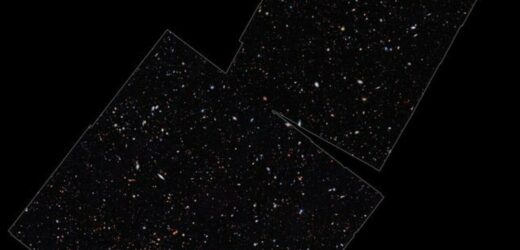NASA reveals first image from James Webb Space Telescope
We use your sign-up to provide content in ways you’ve consented to and to improve our understanding of you. This may include adverts from us and 3rd parties based on our understanding. You can unsubscribe at any time. More info
NASA’s James Webb Space Telescope (JWST) has achieved a new milestone for humanity, after an international team of astronomers has used data from telescope to discover the earliest galaxies confirmed to date. The light from these galaxies has taken over 13.4 billion years to reach us, meaning that these galaxies date back to less than 400 million years after the Big Bang that created the universe. This means that these galaxies were formed when the universe was only about two percent of its current age. Data collected from the JWST earlier had provided suitable candidates for such ancient galaxies.
Now, researchers have confirmed these targets by obtaining spectroscopic observations, revealing characteristic and distinctive patterns in the fingerprints of light coming from these incredibly faint galaxies.
Astronomer and co-author Emma Curtis-Lake from the University of Hertfordshire in the United Kingdom said: “It was crucial to prove that these galaxies do, indeed, inhabit the early universe. It’s very possible for closer galaxies to masquerade as very distant galaxies.
“Seeing the spectrum revealed as we hoped, confirming these galaxies as being at the true edge of our view, some further away than Hubble could see! It is a tremendously exciting achievement for the mission.”
The observations resulted from a collaboration of scientists around the world who led the development of two of the instruments on board Webb, the Near-Infrared Camera (NIRCam) and the Near-Infrared Spectrograph (NIRSpec).


The researchers developed these instruments as part of their quest to investigate the deepest and faintest corners of the universe. In 2015 the instrument teams joined together to propose the JWST Advanced Deep Extragalactic Survey (JADES).
This ambitious program, which was an international collaboration of over eighty astronomers from ten countries, has been allocated just over one month of the telescope’s time spread over two years, and is designed to provide a view of the early universe unprecedented in both depth and detail.
Co-author Marcia Rieke, NIRCam principal investigator, of the University of Arizona in Tucson said: “These results are the culmination of why the NIRCam and NIRSpec teams joined together to execute this observing program.”
The first round of JADES observations focused on the area in and around the Hubble Space Telescope’s Ultra Deep Field, however, the new JWST has significantly boosted their capabilities, providing the faintest and sharpest images yet obtained.

The JADES program began with NIRCam, and used over 10 days of mission time to study the field in nine different infrared colours, which resulted in exquisite images of the sky.
The region is 15 times larger than the deepest infrared images produced by the Hubble Space Telescope, yet is even deeper and sharper at these wavelengths, NASA said.
The image is only the size a human appears when viewed from a mile away. However, it teems with nearly 100,000 galaxies, each caught at some moment in their history, billions of years in the past.
Co-author Brant Robertson from the University of California, Santa Cruz, a member of the NIRCam science team said: “For the first time, we have discovered galaxies only 350 million years after the big bang, and we can be absolutely confident of their fantastic distances. To find these early galaxies in such stunningly beautiful images is a special experience.”
DON’T MISS:
Millions feel energy bills bite as Arctic blast to cost £10 a day [ANALYSIS]
Biden humiliated as Xi strikes huge Gulf energy deal to replace dollar [REVEAL]
Elon Musk unveils SpaceX’ new ‘Starshield’ programme to thwart Russia [REPORT]

Researchers are able to distinguish the galaxies in the early universe through the “tell-tale aspect” of their multi-wavelength colour in the images captures.
As the universe expands, light is stretched in wavelength, and the light from the ancient galaxies have been stretched by a factor of up to 14.
Astronomer and co-author Stefano Carniani, from Scuola Normale Superiore in Italy, said: “These are by far the faintest infrared spectra ever taken
“They reveal what we hoped to see: a precise measurement of the cutoff wavelength of light due to the scattering of intergalactic hydrogen.”
Source: Read Full Article


